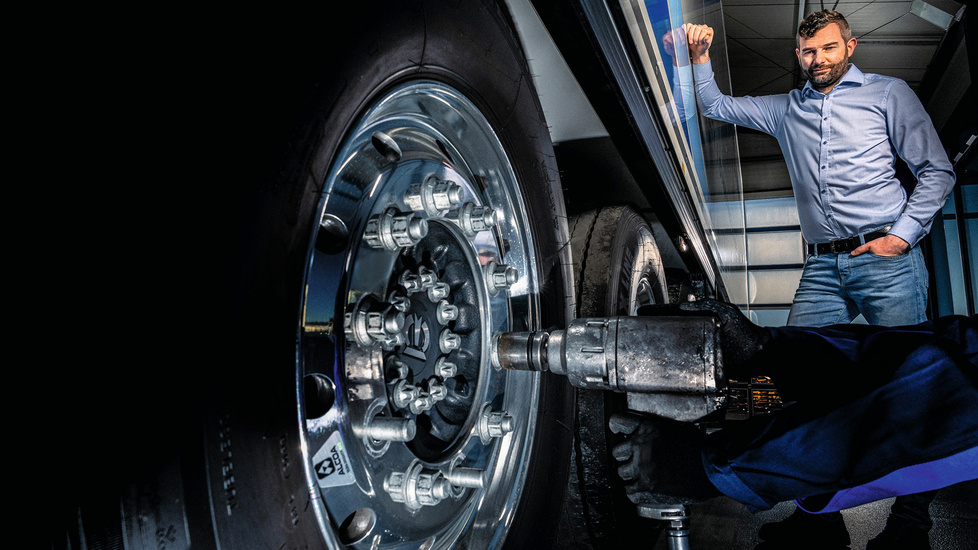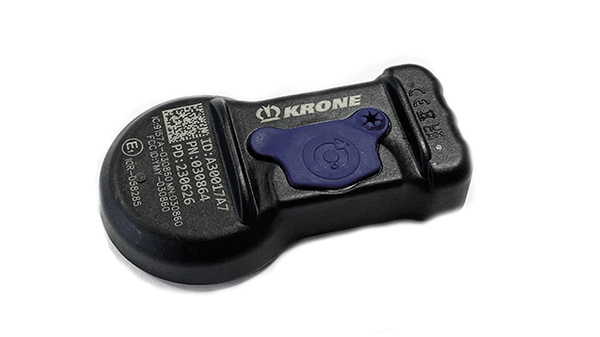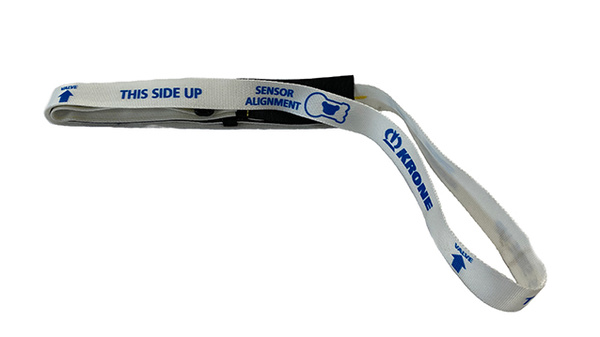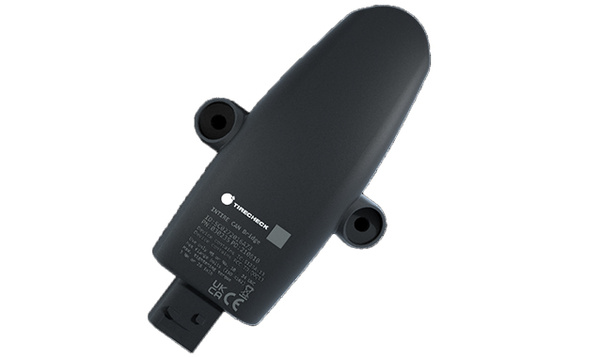
KRONE TPMS
TPMS: UN ECE R141 guideline
UN ECE R141 is the basis for the introduction of the new KRONE TPMS system. This regulation defines standards for tire pressure monitoring systems (TPMS) in commercial vehicles. It also stipulates that all new commercial vehicles with first registration after July 6, 2024 must be equipped with a TPMS system. With this, the UN is aims to reduce the risk of accidents on the road. Accordingly, such a TPMS system monitors the pressure and temperature of all tires installed in the vehicle. If the pressure ever drops by more than 20%, the driver is alerted directly via the TPMS system by displaying a warning signal/ message on the truck's dashboard in the event of the pressure remaining critically low for more than 10 minutes.
How does the KRONE TPMS system work?
The KRONE TPMS system works with sensors that are attached to each wheel. The sensor is attached to the rim with a strap and thus secured in place: tire pressure and temperature data are transmitted by the sensors to a receiver control unit, where they are converted into signals and evaluated. If the pressure of a tire falls below the predefined benchmark set by the UN and therefore reaches a critical low, a warning signal is sent to the truck’s dashboard and thus to the driver via the electronic braking system (EBS).
The display of a TPMS warning in the truck depends on the manufacturer and year of manufacture of the truck. The TPMS sensors communicate with the receiver unit via the 433 MHz frequency, which is then connected to the trailer's EBS system via the CAN bus. The EBS system forwards the TPMS data to the truck unit via the CAN bus. All N2 and N3 truck manufacturers are required by law to display a UN ECE R141-compliant warning signal.
What do I have to consider when using the KRONE TPMS system?
The KRONE TPMS sensor must be calibrated for its position aboard the trailer when changing the wheel and installing a new sensor for which KRONE provides a free-to-use “TPMS Service App”. After changing a wheel with a KRONE TPMS sensor or for an initial operation of a sensor, the app will assist you in calibrating the position by either entering the sensor ID manually into the app or scanning the QR code affixed to the sensor. Within a few seconds the app will connect to the sensor and read its position and status. The app can be downloaded from the App (iOS) and Play (Android) Store in many different languages. The only thing needed is a valid e-mail address.
For drivers
For drivers, the app offers the possibility to receive warnings and information on the tyre pressure and temperature of the trailer. The app therefore enables drivers to access TPMS data regardless of the truck and thus improve safety while driving.
For workshops
There is a separate login option for workshops via the app, which makes it possible to change and replace sensors. This allows the workshop to monitor the condition of the tyres and carry out maintenance work if necessary. A central component of the TPMS is the Receiver Control Unit (RCU), which acts as an interface between the sensors and the vehicle. It translates the data from the sensors and forwards it to the control unit, from where it is transmitted to the cab and, if necessary, to the telematics system. A correct tyre change requires new sensor positions to be taught in order to ensure reliable TPMS functionality. This is crucial for ensuring vehicle safety and efficiency. Similarly, when tyres are changed, a new sensor must be taught and the position on the vehicle defined using the app.
Frequently asked questions
KRONE uses sensors based on TireCheck‘s 433 MHz base protocol. The same protocol is also used by other trailer manufacturers, making it easy to find compatible sensors in tire repair shops. You can also use different sensors on a trailer if all installed sensors have implemented the supported TireCheck protocol.
No. KRONE will only install its own TPMS system on new trailers, as the TPMS system is part of the type approval and must meet the requirements of UN ECE R141.
The driver, as the leader of the rig, is responsible for responding to TPMS alerts. To support this, KRONE offers a mobile app that allows the driver to check the TPMS status and change the sensor IDs if necessary. This app is free and available to everyone. When changing a tire during a puncture, the driver must ensure that a compatible TPMS sensor is mounted on the rim. KRONE uses sensors with the TireCheck basic protocol. We recommend using the official KRONE TPMS sensor.
Yes, today we assume that TPMS exams will be part of the general inspection exam in all relevant countries in the future regarding UN ECE R141. If one or more TPMS sensors do not work, the trailer will be deemed unroadworthy and repairs/upgrades will need to be made.
The TPMS sensors communicate with the receiver unit using the 433 MHz frequency. The receiver unit is then connected to the trailer’s EBS system via the CAN bus. The EBS system then forwards the TPMS data to the tractor via the CAN bus. All tractor manufacturers in classes N2 and N3 are required by law to display a UN ECE R141 compliant warning signal.
UN ECE R141 does not require a telematics option. In general, the TPMS solution must be able to send tire pressure and temperature information to the tractor using the EBS system. The standard is met as soon as the driver has access to the information from the TPMS system.
TPMS data via telematics is a valuable addition to any fleet management system. They can help improve safety, operating costs and vehicle performance. Here are some benefits that TPMS data via telematics offers:
- Improved fleet management: TPMS data can be used by dispatchers to monitor performance and Monitor the condition of trailers in a fleet. This can help improve fleet efficiency and avoid unexpected outages caused by data usage.
- A fleet manager can constantly monitor the tire pressure of all trailers in their fleet from the office. This can help reduce fuel consumption and tire wear.
- Improved customer satisfaction: TPMS data can be used to provide data-based information to drivers and workshops about the condition of the trailers. This can help improve operational security and availability.
- A tire service partner can constantly monitor vehicle tire performance using telematics data. This can help improve the safety and performance of the tires.
- A driver can be notified immediately if a trailer‘s tire pressure drops. This can help prevent an accident.
- Improved environmental sustainability including reporting and secure documentation: TPMS data can help reduce fuel consumption and CO2 emissions. This can help improve environmental sustainability. Thanks to the telematics connection, this data can be used for internal and external reporting (topic ESG reporting)
- Through the use of telematics and the associated availability of TPMS data in the transport company‘s office, queries and telephone calls with the driver are unnecessary. Q. Can I get the TPMS without built-in telematics? A: KRONE installs a telematics unit as standard in every vehicle with a TPMS option.
This depends on the trailer type, lead time and usual pickup time. KRONE will proceed gradually with the transition for trailers, starting with those with the longest lead time. From week 22 2024 every trailer will be equipped with TPMS.
It is not recommended as a tire pressure monitoring system increases safety for the driver and all other road users. It is important to check all tires as soon as possible. A warning is also generated if sensors are missing or data transmission is disrupted.
The display may vary depending on the year of manufacture and model of the truck. In older trucks, for example, only a warning light illuminates if there is a loss of tyre pressure or a sensor fault. On newer models, the temperature and tyre position can be read on the existing vehicle display in addition to the pressure. This allows the affected tyre to be identified directly in the event of a loss of pressure. The driver can also receive the data via the TPMS Service App from KRONE and thus receive notifications in the event of a loss of pressure.
KRONE chose this variant due to market requirements. KRONE closely monitors market developments and continually evaluates which innovations are groundbreaking for further TPMS development.
In the event of a breakdown, the belt and sensor must be visually checked for damage: Does the belt show cracks? Is the fabric unravelling? Is the sensor visually damaged?
If the parts are OK after visual inspection and are displayed via the TPMS Service app, the components can continue to be used. Otherwise, the parts should be replaced.
If only the tyre cover is replaced and the sensor is reinstalled in the strap on the rim in the same position, the sensor does not need to be relearned. If the position of the rim including the belt and sensor changes with the new tyre cover on the trailer, the sensor must be re-calibrated via the KRONE TPMS Service App.
No, the system is immediately ready for operation and is activated during the production process. It is immediately available.



